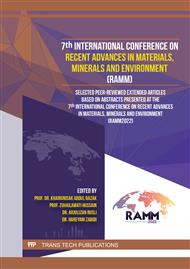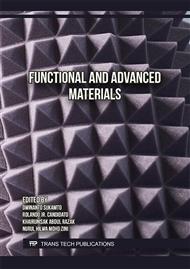[1]
S. Fakhriddin, The main factors influencing the formation of harmful substances in diesel engines, Universum: technical sciences (5-10 (98)) (2022) 62-64.
Google Scholar
[2]
J.E, W. Xu, Y. Ma, D. Tan, Q. Peng, Y. Tan, L. Chen, Soot formation mechanism of modern automobile engines and methods of reducing soot emissions: A review, Fuel Processing Technology 235 (2022) 107373.
DOI: 10.1016/j.fuproc.2022.107373
Google Scholar
[3]
J. Shi, X. Yi, J. Wang, G. Jin, Y. Lu, H. Wu, X. Fan, Carbonaceous soot dispersion characteristic and mechanism in lubricant with effect of dispersants by molecular dynamics simulation and experimental studies, Carbon 200 (2022) 253-263.
DOI: 10.1016/j.carbon.2022.08.043
Google Scholar
[4]
C. Chen, W. Huang, Aggregation Kinetics of Diesel Soot Nanoparticles in Wet Environments, Environmental Science & Technology 51(4) (2017) 2077-2086.
DOI: 10.1021/acs.est.6b04575
Google Scholar
[5]
H.A. Michelsen, M.B. Colket, P.E. Bengtsson, A. D'Anna, P. Desgroux, B.S. Haynes, J.H. Miller, G.J. Nathan, H. Pitsch, H. Wang, A Review of Terminology Used to Describe Soot Formation and Evolution under Combustion and Pyrolytic Conditions, ACS nano 14(10) (2020) 12470-12490.
DOI: 10.1021/acsnano.0c06226
Google Scholar
[6]
A.A. Onischuk, S. di Stasio, V.V. Karasev, A.M. Baklanov, G.A. Makhov, A.L. Vlasenko, A.R. Sadykova, A.V. Shipovalov, V.N. Panfilov, Evolution of structure and charge of soot aggregates during and after formation in a propane/air diffusion flame, Journal of Aerosol Science 34(4) (2003) 383-403.
DOI: 10.1016/s0021-8502(02)00215-x
Google Scholar
[7]
S.J. Harris, I.M. Kennedy, The Coagulation of Soot Particles with van der Waals Forces, Combustion Science and Technology 59(4-6) (1988) 443-454.
DOI: 10.1080/00102208808947110
Google Scholar
[8]
S.F. Kamarudin, M. Jaafar, A. Abd Manaf, Y. Takamura, T. Masuda, Y. Yumoto, Performance Enhancement of Inkjet Printed Multi-Walled Carbon Nanotubes Inks using Synthetic and Green Surfactants, Advanced Materials Technologies 6(5) (2021) 2001026.
DOI: 10.1002/admt.202001026
Google Scholar
[9]
V. Macián, B. Tormos, S. Ruiz, A. García-Barberá, An Alternative Procedure to Quantify Soot in Engine Oil by Ultraviolet-Visible Spectroscopy, Tribology Transactions 62(6) (2019) 1063-1071.
DOI: 10.1080/10402004.2019.1645255
Google Scholar
[10]
S.M.A. Sharif Sheikhaleslami, F. Golestani-Fard, E. Khatibi, H. Sarpoolaky, Dispersion and stability of carbon black nanoparticles, studied by ultraviolet–visible spectroscopy, Journal of the Taiwan Institute of Chemical Engineers 40 (2009) 524–527.
DOI: 10.1016/j.jtice.2009.03.006
Google Scholar
[11]
L. De Campo, A. Yaghmur, N. Garti, M.E. Leser, B. Folmer, O. Glatter, Five-component food-grade microemulsions: structural characterization by SANS, Journal of colloid and interface science 274(1) (2004) 251-267.
DOI: 10.1016/j.jcis.2004.02.027
Google Scholar
[12]
A.R. Bhat, F.A. Wani, K. Behera, A.B. Khan, R. Patel, Formulation of biocompatible microemulsions for encapsulation of anti-TB drug rifampicin: A physicochemical and spectroscopic study, Colloids and Surfaces A: Physicochemical and Engineering Aspects 645 (2022) 128846.
DOI: 10.1016/j.colsurfa.2022.128846
Google Scholar
[13]
Z. Cao, G. Ma, M. Leng, S. Zhang, J. Chen, C. Do, K. Hong, L. Fang, X. Gu, Variable-Temperature Scattering and Spectroscopy Characterizations for Temperature-Dependent Solution Assembly of PffBT4T-Based Conjugated Polymers, ACS Applied Polymer Materials 4(5) (2022) 3023-3033.
DOI: 10.1021/acsapm.1c01511
Google Scholar
[14]
R.A. O'Connell, W.N. Sharratt, N.J.J. Aelmans, J.S. Higgins, J.T. Cabral, SANS Study of PPPO in Mixed Solvents and Impact on Polymer Nanoprecipitation, Macromolecules 55(3) (2022) 1050-1059.
DOI: 10.1021/acs.macromol.1c02030
Google Scholar
[15]
H. Wang, B. Zhao, B. Wyslouzil, K. Streletzky, Small-angle neutron scattering of soot formed in laminar premixed ethylene flames, Proceedings of the Combustion Institute 29(2) (2002) 2749-2757.
DOI: 10.1016/s1540-7489(02)80335-2
Google Scholar
[16]
Y. Lin, T.W. Smith, P. Alexandridis, Adsorption of a rake-type siloxane surfactant onto carbon black nanoparticles dispersed in aqueous media, Langmuir 18(16) (2002) 6147-6158.
DOI: 10.1021/la011671t
Google Scholar
[17]
T. Rajasekhar, G. Singh, G. Kapur, S. Ramakumar, Recent advances in catalytic chain transfer polymerization of isobutylene: a review, RSC Advances 10 (2020) 18180-18191.
DOI: 10.1039/d0ra01945c
Google Scholar
[18]
D. Atkinson, A.J. Brown, D. Jilbert, G. Lamb, Formulation of Automotive Lubricants, in: R.M. Mortier, M.F. Fox, S.T. Orszulik (Eds.), Chemistry and Technology of Lubricants, Springer Netherlands, Dordrecht, 2010, pp.293-324.
DOI: 10.1023/b105569_9
Google Scholar
[19]
C.C. Colyer, W.C. Gergel, Detergents/dispersants, Chemistry and technology of lubricants, Springer1994, pp.62-82.
DOI: 10.1007/978-1-4615-3272-9_3
Google Scholar
[20]
S. Sukirno, D. Febriantini, A.S. Nugraha, B. Purnomo, Optimization and characterization of facile synthesis of pentaethylenehexamine-terminated polyisobutylene, RASĀYAN Journal of Chemistry (2021) 40-46.
DOI: 10.31788/rjc.2021.1456550
Google Scholar
[21]
H. Sun, R. Jiao, G. An, H. Xu, D. Wang, Influence of particle size on the aggregation behavior of nanoparticles: Role of structural hydration layer, Journal of Environmental Sciences 103 (2021) 33-42.
DOI: 10.1016/j.jes.2020.10.007
Google Scholar
[22]
H. Mateos, G. Palazzo, Colloidal stability, Colloidal Foundations of Nanoscience, Elsevier2022, pp.57-83.
DOI: 10.1016/b978-0-12-822089-4.00001-5
Google Scholar
[23]
A. Langford, M. Bruchsaler, M. Gupta, 8 - Suspension properties and characterization of aluminum-adjuvanted vaccines, in: P. Kolhe, S. Ohtake (Eds.), Practical Aspects of Vaccine Development, Academic Press2022, pp.225-266.
DOI: 10.1016/b978-0-12-814357-5.00008-8
Google Scholar
[24]
D.H. Napper, Steric stabilization, Journal of Colloid and Interface Science 58(2) (1977) 390-407.
DOI: 10.1016/0021-9797(77)90150-3
Google Scholar
[25]
H. Abdel-Hameed, N. Ahmed, A. Nassar, Some Ashless Detergent/Dispersant Additives for Lubricating Engine Oil, 2015.
DOI: 10.1108/ilt-05-2015-0065
Google Scholar
[26]
F. Matter, A.L. Luna, M. Niederberger, From colloidal dispersions to aerogels: How to master nanoparticle gelation, Nano Today 30 (2020) 100827.
DOI: 10.1016/j.nantod.2019.100827
Google Scholar
[27]
S. Asakura, F. Oosawa, On interaction between two bodies immersed in a solution of macromolecules, The Journal of chemical physics 22(7) (1954) 1255-1256.
DOI: 10.1063/1.1740347
Google Scholar
[28]
Y.-J. Yang, D.S. Corti, E.I. Franses, Effect of Triton X-100 on the stability of titania nanoparticles against agglomeration and sedimentation: A masked depletion interaction, Colloids and Surfaces A: Physicochemical and Engineering Aspects 516 (2017) 296-304.
DOI: 10.1016/j.colsurfa.2016.12.026
Google Scholar
[29]
J. Vialetto, M. Anyfantakis, Exploiting Additives for Directing the Adsorption and Organization of Colloid Particles at Fluid Interfaces, Langmuir 37(31) (2021) 9302-9335.
DOI: 10.1021/acs.langmuir.1c01029
Google Scholar
[30]
L.R. Rudnick, Lubricant Additives: Chemistry and Applications, CRC Press2017.
Google Scholar
[31]
Y. Kim, J. Kim, D.H. Hyeon, J.S. Han, B.-H. Chun, B.H. Jeong, S.H. Kim, Development of PIBSI type dispersants for carbon deposit from thermal oxidative decomposition of Jet A-1, Fuel 158 (2015) 91-97.
DOI: 10.1016/j.fuel.2015.05.008
Google Scholar
[32]
J. Barker, J. Reid, C. Snape, D. Scurr, W. Meredith, Spectroscopic studies of internal injector deposits (IDID) resulting from the use of non-commercial low molecular weight polyisobutylenesuccinimide (PIBSI), SAE International Journal of Fuels and Lubricants 7(3) (2014) 762-770.
DOI: 10.4271/2014-01-2720
Google Scholar
[33]
K. Vyavhare, S. Bagi, M. Patel, P.B. Aswath, Impact of diesel engine oil additives–soot interactions on physiochemical, oxidation, and wear characteristics of soot, Energy Fuels 33(5) (2019) 4515-4530.
DOI: 10.1021/acs.energyfuels.8b03841
Google Scholar
[34]
Z. Pawlak, B.E. Klamecki, T. Rauckyte, G.P. Shpenkov, A. Kopkowski, The tribochemical and micellar aspects of cutting fluids, Tribology International 38(1) (2005) 1-4.
DOI: 10.1016/j.triboint.2004.04.004
Google Scholar
[35]
R. Esparza, M. Ba, E. Pérez, A. Gama Goicochea, Importance of molecular interactions in colloidal dispersions, Advances in Condensed Matter Physics (2015).
DOI: 10.1155/2015/683716
Google Scholar



